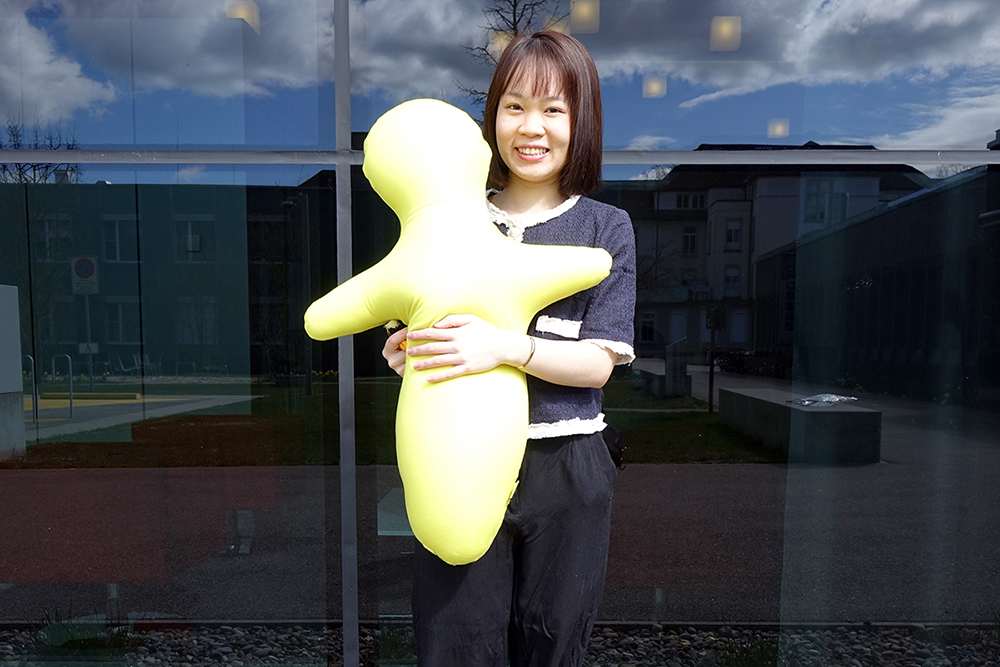As part of the AAAI 2023 Spring Symposia in San Francisco, the symposium “Socially Responsible AI for Well-being” is organized by Takashi Kido (Teikyo University, Japan) and Keiki Takadama (The University of Electro-Communications, Japan). The paper “Increasing Well-being and Health through Robotic Hugs” by Oliver Bendel, Andrea Puljic, Robin Heiz, Furkan Tömen, and Ivan De Paola was accepted. Among other things, they show how people in Switzerland react to robotic hugs. The talk will take place between March 26 and 29, 2023 at Hyatt Regency, San Francisco Airport. The symposium website states: “For our happiness, AI is not enough to be productive in exponential growth or economic/financial supremacies but should be socially responsible from the viewpoint of fairness, transparency, accountability, reliability, safety, privacy, and security. For example, AI diagnosis system should provide responsible results (e.g., a high-accuracy of diagnostics result with an understandable explanation) but the results should be socially accepted (e.g., data for AI (machine learning) should not be biased (i.e., the amount of data for learning should be equal among races and/or locations). Like this example, a decision of AI affects our well-being, which suggests the importance of discussing ‘What is socially responsible?’ in several potential situations of well-being in the coming AI age.” (Website AAAI) According to the organizers, the first perspective is “(Individually) Responsible AI”, which aims to clarify what kinds of mechanisms or issues should be taken into consideration to design Responsible AI for well-being. The second perspective is “Socially Responsible AI”, which aims to clarify what kinds of mechanisms or issues should be taken into consideration to implement social aspects in Responsible AI for well-being. More information via www.aaai.org/Symposia/Spring/sss23.php#ss09.
The HUGGIE Project II
A large survey on hugging robots was already conducted in 2020 (HUGGIE Project I). The results were published by Leonie Stocker, Ümmühan Korucu, and Oliver Bendel in the book chapter “In den Armen der Maschine” (“In the arms of the machine”) in the Springer volume “Soziale Roboter” (“Social Robots”) . In the summer of 2022, another project was announced at the School of Business FHNW, called HUGGIE Project II in distinction to the previous project. A team of four was recruited, with Andrea Puljic, Robin Heiz, Furkan Tömen, and Ivan De Paola. The task was to build and test a hugging robot called HUGGIE. In doing so, the results of HUGGIE Project I were to be used as a basis. In particular, it was to be determined whether a robotic hug contributes to well-being and health and whether voice and vibration as a simulation of the heartbeat as well as scent increase the acceptance of the hug by a robot. Thus, indications from the survey in HUGGIE Project I were included. Furthermore, hugs with a giant stuffed animal named Teddy took place for comparison. The results show that people benefit from robotic hugs and that these can increase their well-being and health as a result. There was clear evidence of this in the pretest, and still sufficient evidence in the main test. However, some already have an aversion to robotic hugs in their imagination – as HUGGIE Project I revealed – which in turn some also showed in reality (HUGGIE Project II). Warmth and softness of body and arms are important. This was already proven by the research of Alexis E. Block and Katherine J. Kuchenbecker. Voice, vibration, and scent were found to be less relevant. However, there is significant indication that a female voice can increase acceptance and therefore needs to be further explored and adapted in this context. The findings were summarized in a paper and submitted to an international conference (Photo: Furkan Tömen).
Hugged by a Robot
The HUGGIE project at the School of Business FHNW is moving forward. Under the supervision of Prof. Dr. Oliver Bendel, the team of four (Andrea Puljic, Robin Heiz, Ivan De Paola, Furkan Tömen) will test a hug doll on users until January 2023. It is already known that warmth and softness of the arms and body are desired. Now the team is investigating whether, for example, voice, vibration and smell also increase acceptance. The key question of the practical project is: Can a social robot help increase physical and mental well-being through hugs and touches, and what factors should be taken into account? The basis of HUGGIE is a dressmaker’s dummy. Added to this are clothing, a warming element, a vibration element, and an audio system. In addition, a scent is applied. The arms are moved by invisible strings so that active hugs are possible. Overall, the impression of a hugging robot is created. A trial run with 65 test persons took place in a Swiss company in November 2022. They were hugged by HUGGIE and a giant teddy bear. Based on the results and impressions, the questionnaire and the test setup will be improved. From the end of November 2022, the project will enter its final phase, with implementation and evaluation of the tests.
The New Life of Hugvie
How can you make social robots out of simple, soft shapes and objects, i.e. robots for interacting with people and animals? Under the supervision of Prof. Dr. Oliver Bendel, Vietnamese students Nhi Hoang Yen Tran and Thang Vu Hoang are investigating this question in the project “Simple, Soft Social Robots” at the School of Business FHNW. They are using Hugvie from the Hiroshi Ishiguro Laboratories as a basis – these labs are particularly famous for the Geminoid and for Erica. But hugging robots like Telenoid also come from them. The latest product from this series is Hugvie. A pocket for a smartphone is attached to its head. People who are far away from each other can talk to each other and have the feeling of hugging and feeling each other. But what else can you do with Hugvie and similar forms? Can you make them conversationalists themselves, can you teach them to move their limbs and be active in other ways? And what does such robotization of simple, soft forms and objects mean for everyday life and society?
A Prod, a Stroke, or a Hug?
Soft robots with transparent artificial skin can detect human touch with internal cameras and differentiate between a prod, a stroke, or a hug. This is what New Scientist writes in its article “Robot that looks like a bin bag can understand what a hug is“. According to the magazine, the technology could lead to better non-verbal communication between humans and robots. What is behind this message? A scientific experiment that is indeed very interesting. “Guy Hoffman and his colleagues at Cornell University, New York, created a prototype robot with nylon skin stretched over a 1.2-metre tall cylindrical scaffold atop a platform on wheels. Inside the cylinder sits a commercial USB camera which is used to interpret different types of touch on the nylon.” (New Scientist, 29 January 2021) In recent years, there have been several prototypes, studies and surveys on hugging robots. For example, the projects with PR2, Hugvie, and HUGGIE are worth mentioning. Cornell University’s research certainly represents another milestone in this context and in a way puts humans in the foreground.
Findings on Robotic Hugging
In the first part of the HUGGIE project initiated by Oliver Bendel, two students of the School of Business FHNW conducted an online survey with almost 300 participants. In the management summary of their bachelor thesis Ümmühan Korucu and Leonie Stocker (formerly Leonie Brogle) write: “The results of the survey indicated that people have a positive attitude towards robots in general as robots are perceived as interesting and useful rather than unnecessary and disturbing. However, only a minority of the participants stated that they would accept a hug from a robot. A possible reason for this could be that for the majority of participants, a hug is an act of intimacy with a deeper meaning attached to it which is only being shared with selected persons. For a robot to be perceived as an attractive hugging partner, a human-like design including a face, eyes, a friendly look as well as the ability to communicate verbally and non-verbally is desired. However, an appearance being too realistic has a deterrent effect. Furthermore, an in-depth analysis of the data in relation to age and gender of the participants resulted in the discovery of interesting facts and differences. Overall, the findings contribute to a clearer picture about the appearance and the features Huggie should have in order to be accepted as a hugging counterpart.” The bachelor thesis will be publicly available in autumn 2020. There will also be a paper with the results next year.
Online Survey on Hugs by Robots
Embraces by robots are possible if they have two arms, such as Pepper and P-Care, restricted also with one arm. However, the hugs and touches feel different to those made by humans. When one uses warmth and softness, like in the HuggieBot project, the effect improves, but is still not the same. In hugs it is important that another person hugs us (hugging ourselves is totally different), and that this person is in a certain relationship to us. He or she may be strange to us, but there must be trust or desire. Whether this is the case with a robot must be assessed on a case-by-case basis. A multi-stage HUGGIE project is currently underway at the School of Business FHNW under the supervision of Prof. Dr. Oliver Bendel. Ümmühan Korucu and Leonie Brogle started with an online survey that targets the entire German-speaking world. The aim is to gain insights into how people of all ages and sexes judge a hug by a robot. In crises and catastrophes involving prolonged isolation, such as the COVID 19 pandemic, proxy hugs of this kind could well play a role. Prisons and longer journeys through space are also possible fields of applications. Click here for the survey (only in German): ww3.unipark.de/uc/HUGGIE/ …
The HUGGIE Project
The first phase of the HUGGIE project will start at the School of Business FHNW in March 2020. Oliver Bendel was able to recruit two students from the International Management program. The project idea is to create a social robot that contributes directly to a good life and economic success by touching and hugging people and especially customers. HUGGIE should be able to warm up in some places, and it should be possible to change the materials it is covered with. A research question will be: What are the possibilities besides warmth and softness? Are optical stimuli (also on displays), vibrations, noises, voices etc. important for a successful hug? HUGGIE could also play a role in crises and disasters, in epidemics and pandemics and in cases of permanent social distancing. Of course it would be bad if only a robot would hug us, and of course it would be good if humans could hug us every day if we wanted them to do so – but maybe in extreme situations a hug by a robot is better than nothing. The HUGGIE project is located in the heart of social robotics and on the periphery of machine ethics. It is inspired by the work of Ishiguro, but especially by the research on HuggieBot. By summer 2020, the students will conduct an online survey to find out the attitudes and expectations of the users.







